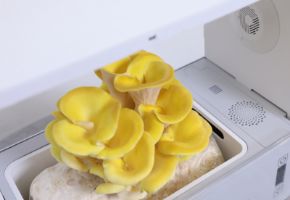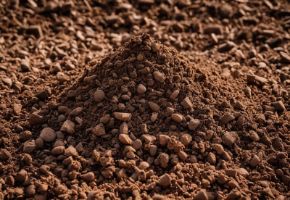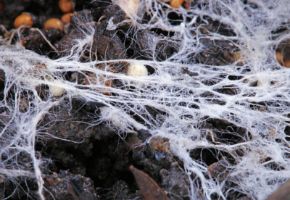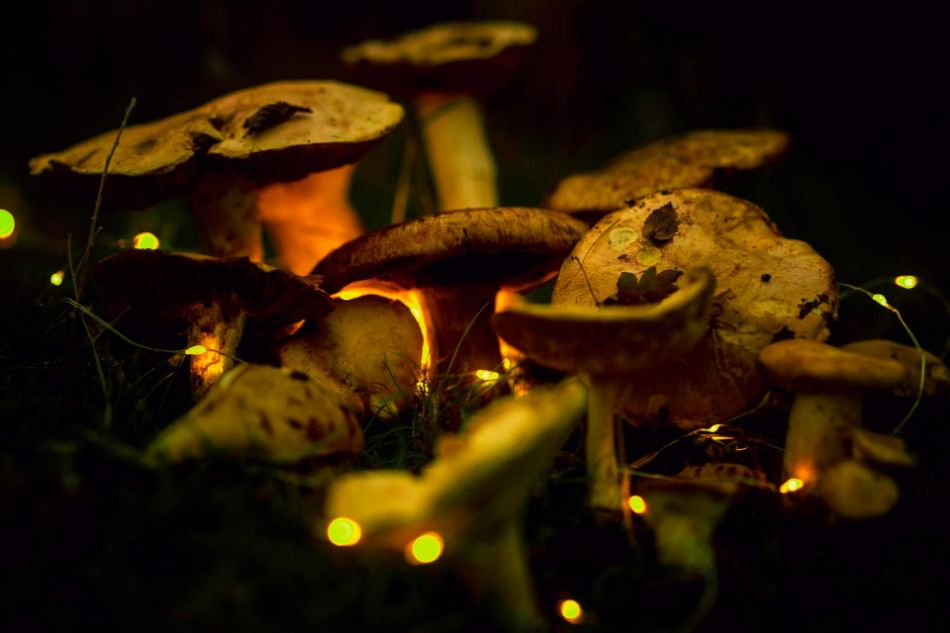Imagine yourself in a tropical forest at night, where the air is so thick you can almost touch it. As you move cautiously, your gaze is caught by a faint greenish-blue glow pulsating among the tree roots. You approach and discover that mysterious light comes from... a mushroom! It's not an optical illusion nor a hallucination: you're observing one of the most fascinating phenomena of the fungal kingdom - bioluminescence. In this article, I'll take you on an extraordinary journey to discover these living organisms that challenge our understanding of nature, exploring not only where and how they grow, but above all the mysterious mechanism that makes them glow in the dark.
Before diving into the heart of this phenomenon, let's take a step back to understand exactly what we're dealing with. Bioluminescent mushrooms aren't simply fungi that reflect light, as one might sometimes think. No, here we're talking about organisms that actively produce light through complex biochemical reactions. It's the same principle that makes fireflies or some deep-sea fish glow, but with unique characteristics in the fungal world. To understand how this natural magic works, we need to delve into the biochemistry of these extraordinary organisms. Everything revolves around two key molecules: luciferin and the enzyme luciferase. Luciferin (whose name comes from the Latin "lux-ferre", light-bearer) is an organic compound that, when oxidized by the luciferase enzyme in the presence of oxygen, emits photons of light. The incredible thing is that all this happens with extraordinary energy efficiency: almost 100% of the chemical energy is converted into light, without significant heat production (which is why it's called "cold light"). But how exactly do mushrooms activate this process? Recent studies published in Nature have discovered that in mushrooms, bioluminescence is regulated by circadian rhythm, just like our sleep-wake cycle. This means mushrooms "light up" mainly at night, when the emitted light can be most effective for their biological purposes. A fascinating detail is that the light intensity varies by species: while Armillaria mellea produces a faint, almost ghostly glow, the Mycena luxaeterna discovered in Brazil can illuminate an entire area several centimeters wide with light clearly visible to the human eye even under a full moon. Not all mushrooms possess this extraordinary ability. Of over 100,000 known fungal species, only about 80 exhibit bioluminescence. Among these, some are particularly noteworthy: This is perhaps the question that has most intrigued scientists and naturalists for centuries. Why would a mushroom "waste" energy to produce light? There are several theories, and the truth likely lies in a combination of factors. The most credited theory is that the light serves to attract nocturnal insects that, drawn by the luminescence, approach the mushroom and disperse its spores. A groundbreaking study conducted in Brazil and published in ScienceDirect showed that bioluminescent mushrooms attract up to 50% more insects than non-luminous species. But there's more: the attracted insects are often nocturnal species particularly efficient at spore transport, demonstrating fascinating co-evolution between mushrooms and insects. Another suggestive hypothesis is that bioluminescence serves as a warning to herbivorous animals. Many luminous species (like Omphalotus olearius) are actually poisonous to humans and likely other animals too. The light could therefore be the fungal equivalent of poison dart frogs' bright colors: a clear message saying "don't eat me!". Some researchers have proposed that light might influence wood decomposition by these mushrooms, perhaps activating particular enzymes or protecting the mycelium from competing bacteria. While fascinating, this theory still needs experimental confirmation. Now that we know what they are and why they glow, you're probably wondering where and how to admire this natural spectacle. Here's a practical guide for enthusiasts. Some places are true sanctuaries for lovers of luminous mushrooms: Why not plan your next vacation in one of these fabulous places? Observing bioluminescent mushrooms requires patience and some precautions: For the more intrepid enthusiasts, growing bioluminescent mushrooms at home is an unforgettable experience. Here's everything you need to know. Not all luminous species are suitable for home cultivation. The most manageable are: For detailed scientific information on cultivation, consult resources on NCBI. After several attempts, I managed to stabilize a colony of Mycena chlorophos in my home laboratory. Here's what I learned: Ideal substrate: a mix of sterilized oak sawdust, wheat bran, and a pinch of agricultural gypsum seems to work best. The sawdust should be partially decomposed - I've noticed that too fresh material doesn't give good results. Environmental conditions: maintaining a constant temperature of 23°C (±1°C) is crucial. Relative humidity should fluctuate between 85% and 90%. I use a small ultrasonic humidifier controlled by a hygrostat. Lighting: contrary to what one might think, mushrooms need a regular light/dark cycle (12/12 hours) to develop good bioluminescence. I use a weak blue LED light during the "day". If you're interested in experimenting with fungal cultivation in general, I recommend starting small, with a Grow Box. Before science explained the phenomenon of bioluminescence, luminous mushrooms inspired myths and legends worldwide. In Japanese tradition, fungal luminescence was called "foxfire" and was believed to be the work of kitsune, fox spirits endowed with magic. Farmers avoided woods where this phenomenon manifested, fearing they might fall victim to curses. For the Yanomami of Brazil, luminous mushrooms are souls of the deceased who haven't completed their journey to the afterlife. According to their tradition, these spirits use light to attract the living and lead them on secret paths through the forest. Bioluminescent mushrooms represent one of the most extraordinary manifestations of our planet's biodiversity. Beyond their undeniable aesthetic appeal, these organisms might hide scientific secrets of enormous value: from the new class of enzymes discovered in Neonothopanus gardneri to potential biomedical applications of fungal luciferin in diagnostics. Unfortunately, many natural habitats of these species are threatened by deforestation and climate change. That's why supporting research and conservation of these extraordinary organisms is crucial. Perhaps one day, fully understanding their functioning, we might even develop new forms of sustainable lighting inspired by nature. Next time you find yourself in a forest at night, remember to turn off your flashlight and let your eyes adjust to the darkness. Who knows, you might be lucky enough to witness the magical spectacle of these extraordinary luminous mushrooms. The fungal kingdom is a universe in continuous evolution, with new scientific discoveries emerging every year about their extraordinary benefits for gut health and overall well-being. From now on, when you see a mushroom, you will no longer think only of its taste or appearance, but of all the therapeutic potential it holds in its fibers and bioactive compounds. ✉️ Stay connected - Subscribe to our newsletter to receive the latest studies on: Nature offers us extraordinary tools to take care of our health. Fungi, with their unique balance between nutrition and medicine, represent a fascinating frontier we are only beginning to explore. Continue to follow us to discover how these extraordinary organisms can transform your approach to well-being.What are bioluminescent mushrooms? The science of living light
A hidden chemical laboratory in the myceliumA rarity in the fungal kingdom
The fascinating mystery: why do mushrooms glow?
The insect attraction hypothesis: a brilliant reproductive strategy
Light as a defense system: a warning signal
A role in nutrient cycling?
Where and how to observe bioluminescent mushrooms
The most spectacular locations worldwide
When and how to look for them
Growing luminous mushrooms: a domestic adventure
Species suitable for domestic cultivation
My experience growing Mycena chlorophos
Legends and meanings of luminous mushrooms
Japanese foxfire and forest spirits
Ghost mushrooms of Amazonian tribes
Bioluminescent mushrooms: a phenomenon to protect and study
Continue your journey into the world of fungi










